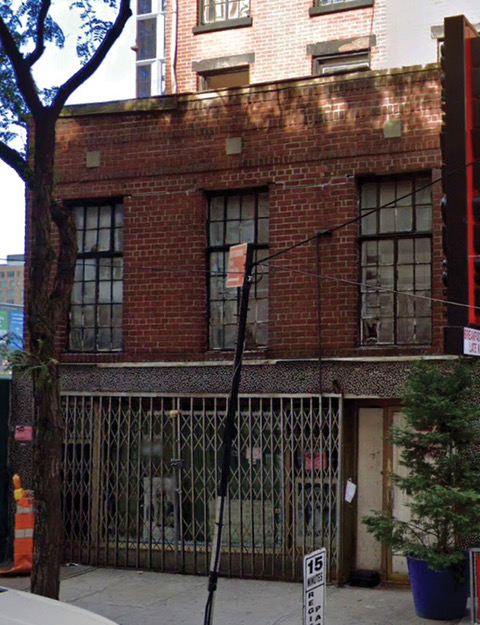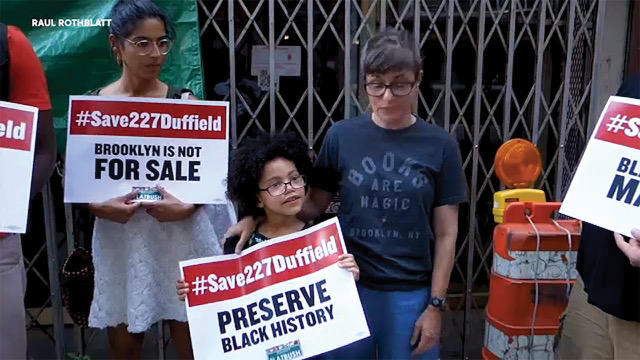As Black Lives Matter Protestors Make History, Some Are Fighting to Save A Historic Black Site From Demolition

Following George Floyd’s death this May, thousands of Brooklynites, just like community members from so many cities across the country, gathered. Congregating at Grand Army Plaza, the protestors marched and chanted in solidarity with the Black Lives Matter movement, calling for police reform and fundamental changes to end systemic racism.
The protests heard around the world are historic in their own right. However, just four months prior, and less than two miles away, activists were rallying for a separate cause. Their chant: “Black landmarks matter.” Assembling outside the Barclays Center this past February, the activist marched to fight the demolition of, and grant Landmark Status to 227 Duffield Street— a building long believed to be an entrance and safe-house along the Underground Railroad.
What You Need To Know About 227 Duffield Street

Located between Fulton and Willoughby Street, Duffield Street was co-named Abolitionist Place in 2007. The unassuming redbrick building has long been in jeopardy. It was built circa 1848 and was owned by Harriet and Thomas Truesdell. The Truesdells were abolitionists who moved to Brooklyn from Rhode Island in 1850— a time when anti-slavery sentiment wasn’t prevalent in New York City and the same year the Fugitive Slave Law was passed.
Because there had to be a secrecy to Underground Railroad activity, documentation is limited. Which makes it more difficult to officially verify who and what was involved. Much of Duffield’s history has been passed down through oral history. There are several insights, however, that strengthen the building’s ties to to the Underground Railroad. For starters, it’s in between Plymouth Church on Ocean Street and Bridge Street AME Church on Stuyvesant Avenue, two noted Underground Railroad stops. Then there are maps and property records from the mid 1800s with lines running east to west that link buildings on Duffield Street to each other.

The most commonly brought up point though: The tunnels. Chatel, who owned the building from 1998 until her death in 2014, was passionate in researching the history of her home and noted an archway in the building’s sub-basement sealed off with boulder. “Look at that tunnel! Tell me what that looks like!” she said during an interview in 2007 with the Brooklyn Rail. Likewise, Lewis Greenstein, who inherited the building at 233 Duffield Street after his mother passed in 1992, noticed alcoves that looked like fireplaces, shafts leading to the street, and a circular shape on the floor, all on the lower floor and cemented over.
The First Fight To Keep The Duffield Properties
Chatel and Greenstein started to organize in 2004 when they learned their properties were within the scope of the Downtown Brooklyn Redevelopment Plan and at risk of being taken under eminent domain. Once the two challenged the Economic Development Corporation during an open review of the redevelopment plan, the city agreed to commission a report from the consulting firm AKRF to look into the historic merit of the buildings.

Two years later, AKRF concluded that there wasn’t enough evidence to state a clear connection between the Underground Railroad and the properties. But Chatel and Greenstein were critical about the way the firm handled the research. By this time they had formed the Duffield Street Block Association and had made connections with local activists who also found the report troublesome. These critics said AKRF left out key pieces of data, like the key to the map that showed connecting lines between the buildings. They also left out the opinions of eight of their twelve peer-reviewers, who had concerns with the evaluation. More troublesome, AKRF didn’t hire an archaeologist to look into the tunnels.
In June 2007, a non-profit law firm filed a lawsuit against the city on behalf of the activists. In November, they won the case narrowly. Chatel’s lawyer, Jennifer Levy, said at the time that the city settled the case because they realized it was the fastest way to continue with the rest of the development plans.
The battle in 2007 was a victory for Chatel, Greenstein and the other activists. But the close attempt to demolish one of the few remaining sites of Black history in Downtown Brooklyn in favor of parking garages was a sign of things to come. It also raised the question: Why shouldn’t the Landmarks Preservation Commission grant this building landmark status?
